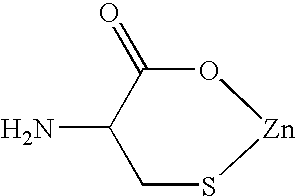Zinc-monocysteine complex and method of using zinc-cysteine complexes
a zinc-cysteine complex and zinc-monocysteine technology, applied in the field of nutritional supplements, can solve the problems of low cysteine level, more susceptible to oxidative damage, and unknown etiology, and achieve the effect of increasing the activity of antioxidant enzymes
- Summary
- Abstract
- Description
- Claims
- Application Information
AI Technical Summary
Benefits of technology
Problems solved by technology
Method used
Image
Examples
example 1
[0036] A zinc-monocysteine complex was formed by the following method:
[0037] L-cysteine (50 g, 100 mmol) was dissolved in water and 100 g of zinc (metal) was added. The mixture was heated to 85 degrees C. for 2 hours. The mixture was filtered to remove unreacted solid residue. The mixture was then placed in an ethanol dry ice bath and evaporated to dryness.
[0038] The present inventors believe that they are the first to use zinc metal (as opposed to zinc salts) to form a zinc-cysteine complex.
[0039] The present inventors believe that they are the first to provide scientific evidence, that is, physical chemical evidence, that their method may have produced a true zinc-monocysteine molecule.
[0040] The zinc-monocysteine complex so formed had the following formula: C3H5NSO2Zn. It can be diagrammed as follows:
[0041] The L-cysteine and zinc combined in a ratio of 1:1 (L-cysteine:Zn).
[0042] The zinc-monocysteine complex so formed was tested in the following experiment:
[0043] The sam...
example 2
[0048] A second (preferred) example is disclosed in the paper entitled “Preparation and Analysis of a Zinc cysteine Compound”, incorporated herein by reference, attached to U.S. patent application Ser. No. 09 / 756,152. In this example, preparation of the zinc-monocysteine complex occurs as follows:
[0049] L-cysteine hydrochloride (50 g) was dissolved in water (200 ml; a 100 mmol solution) and zinc metal (130 g; 2 mol) was added. The reaction mixture was slowly heated to 85 degrees C. over 15 minutes and stirred on a heated mixing plate for an additional 2 hours. The mixture was filtered and the solid residue discarded (136.87 g). The mixture was then placed in an ethanol dry ice bath and evaporated to solid residue (41.65 g; 84% recovery). This method produces a zinc-monocysteine complex.
[0050] Dosage and methods of administration for Example 2 can be as in Example 1.
[0051] One could test the efficacy of the zinc-cysteine complex of the present invention by using the methodology o...
PUM
| Property | Measurement | Unit |
|---|---|---|
| concentrations | aaaaa | aaaaa |
| antioxidant capacity | aaaaa | aaaaa |
| chemical | aaaaa | aaaaa |
Abstract
Description
Claims
Application Information
 Login to View More
Login to View More - R&D
- Intellectual Property
- Life Sciences
- Materials
- Tech Scout
- Unparalleled Data Quality
- Higher Quality Content
- 60% Fewer Hallucinations
Browse by: Latest US Patents, China's latest patents, Technical Efficacy Thesaurus, Application Domain, Technology Topic, Popular Technical Reports.
© 2025 PatSnap. All rights reserved.Legal|Privacy policy|Modern Slavery Act Transparency Statement|Sitemap|About US| Contact US: help@patsnap.com



